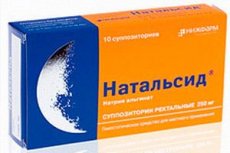Medical expert of the article
New publications
Preparations
Natalcid in pregnancy
Last reviewed: 08.07.2025

All iLive content is medically reviewed or fact checked to ensure as much factual accuracy as possible.
We have strict sourcing guidelines and only link to reputable media sites, academic research institutions and, whenever possible, medically peer reviewed studies. Note that the numbers in parentheses ([1], [2], etc.) are clickable links to these studies.
If you feel that any of our content is inaccurate, out-of-date, or otherwise questionable, please select it and press Ctrl + Enter.

Doctors often prescribe Natalsid during pregnancy. What is this drug for? Its main purpose is to heal anal fissures caused by hemorrhoids. Pregnancy is a period of significant stress on the body. This affects almost every organ, so chronic diseases often worsen and new ones appear at this time. Hemorrhoids occur due to increased pressure on internal organs. It manifests itself in sudden pain, inflammation and bleeding from the anus. It is important to take action in time and cure the disease, otherwise the number of anal fissures will increase, non-healing ulcers will appear, endless pain and constipation will torment. Moreover, advanced hemorrhoids can provoke dysfunction of internal organs, manifested in severe intoxication of the body and constant headaches.
Method of administration and dosage of Natalsid during pregnancy
For the treatment of pregnant women, it is prescribed to insert one suppository twice a day for one to two weeks. The suppositories are inserted after bowel movement. In case of constipation, it is necessary to do a cleansing enema beforehand. For the enema, you can prepare a solution: 1 teaspoon of soda and 2 teaspoons of salt per liter of heated water.
It is more convenient to insert suppositories in the side-lying position. The preparation is inserted deep into the rectum so that the suppository is behind the anal sphincter. It is recommended to use sterile gloves. This will prevent damage to the delicate mucous membrane of the rectum and injury to the thin hemorrhoidal capillaries.
Natalsid consists of natural components extracted from brown seaweed, so it is absolutely harmless and safe during pregnancy. There are no contraindications for use even in the early stages of pregnancy and during lactation. The only possible side effects of Natalsid during pregnancy are allergies due to intolerance to the drug. There is no data on Natalsid overdose and interaction with other drugs. The shelf life of Natalsid, subject to storage conditions (temperature up to +25 degrees) is 3 years.
Natalsid during pregnancy does not harm the health of the expectant mother, which means that the baby in the womb is also safe.
Can Natalsid be taken during pregnancy?
Natalsid is a suppository for the anus. Due to the form of Natalsid, it is suitable for use during pregnancy. It is better tolerated by the body, unlike tablets, which can negatively affect the liver or stomach. The pharmacodynamics described in the instructions for the drug indicate that Natalsid stops the development of the inflammatory process and relieves pain in the anus. As a result, the affected tissues are restored faster. The active ingredients of the drug are sodium analginate and vitespol. Their combined action cures hemorrhoids in a fairly short time. In addition, Natalsid prevents the absorption of water by the intestines, restoring the ability of the intestines to cleanse themselves normally. Data on the pharmacokinetics of the drug are not provided in the instructions.
Indications for the use of Natalsid during pregnancy:
- microcracks of the anus;
- chronic bleeding from the anus;
- fistulas of the rectal or anal mucosa;
- inflammation in the rectum.
Attention!
To simplify the perception of information, this instruction for use of the drug "Natalcid in pregnancy" translated and presented in a special form on the basis of the official instructions for medical use of the drug. Before use read the annotation that came directly to medicines.
Description provided for informational purposes and is not a guide to self-healing. The need for this drug, the purpose of the treatment regimen, methods and dose of the drug is determined solely by the attending physician. Self-medication is dangerous for your health.


 [
[